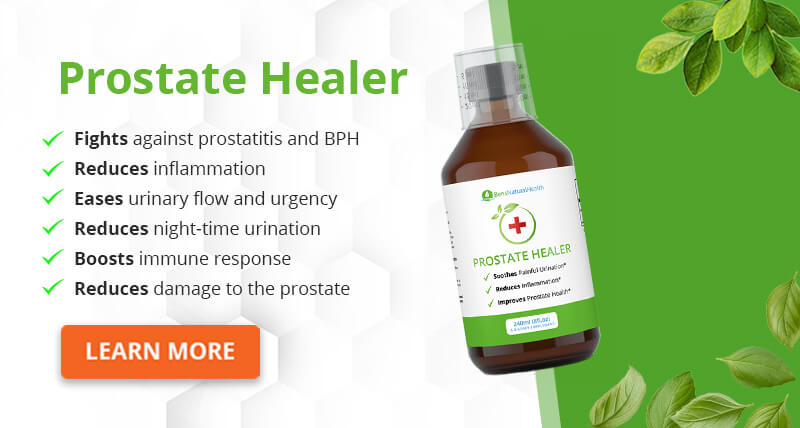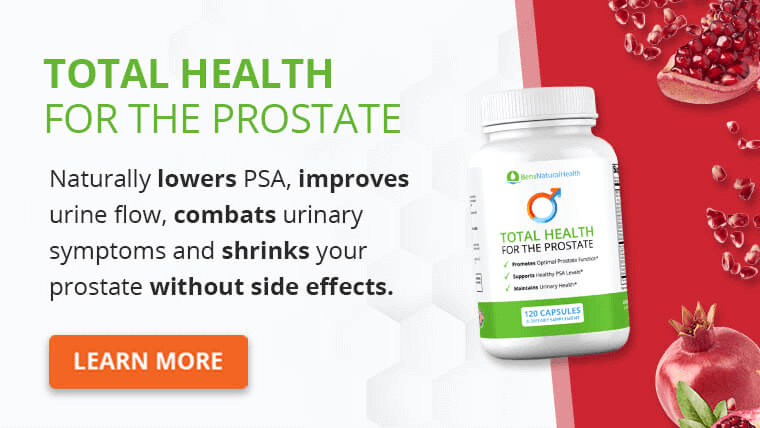Why am I peeing all the time?
If you’ve been peeing a lot, then you certainly want to get to the bottom of it.
Most of the time, the urgent need to urinate results from a urinary tract infection (UTI).
But, when there is an urgency to urinate but no UTI, what could be causing the problem?
Evidence shows that an overactive bladder (OAB) is common.
It affects up to 33 million American adults. That roughly includes 40% of women and 30% of men.
But the numbers could be higher considering many patients feel embarrassed to get help.
If you constantly need to pee but have no signs of a UTI, then this guide can help.
Here, we compiled some other causes of urinary urgency that can help you figure out what’s happening with your body. We also cover some practical treatment and prevention options.
Sign Up For Our Newsletter!
- Receive 10% off our best-selling supplements
- Get Your FREE PSA Lowering Diet Plan
- Be the first to hear about sales and promotions
- Stay up to date on our latest health news
What is urinary urgency?
Urinary urgency is strong, overwhelming, and sudden urges to urinate. You can experience discomfort in the bladder unless you empty it.
Most of the time, the bladder can store urine long enough for you to get to the nearest bathroom. And people typically need to empty it 4-8 times a day.
Urination urgency creates a compelling desire to pass urine. And this desire is hard to control. It is the cornerstone symptom of an overactive bladder.
In many patients, urgent and frequent urination can affect the quality of life. And often requires attention from a healthcare provider. (1)
Dysuria is the discomfort you are feeling due to urination. Abnormally frequent urination (i.e., peeing every 1 hour or 2 hours) is called urinary frequency. If you have urges to pee more than 8 times a day or you wake up in the middle of the night to run to the bathroom, then it’s important to figure out the causes. (2)
Can urinary urgency be a sign of a UTI?
An urgency to urinate is a common sign of UTI. Urgency, frequency, and dysuria often occur together. Many patients experience the constant urge to pee in the middle of the night. The UTI can also turn their pee dark and cloudy or give it a pungent smell.
Because of a UTI, frequent urination in females and males can come with bloody pee, increased body temperature, and pain.

What causes an urgency to urinate with no UTI?
A UTI is not the only health problem that can lead to a frequent urge to pee and an urgency to urinate.
Different urgency urination causes can affect the urinary tract. The urinary tract includes the bladder, kidneys, and the tube connecting the bladder to the kidneys (ureter), including the urethra.
Several common urine urgency causes exist. These are:
- Caffeine intake
- Infection and swelling of the urethra
- Vaginitis (discharge or swelling of the vagina and vulva)
- Nerve-related problems (such as nerve damage)
Less common urges to urinate causes include:
- Alcohol use
- Spine problems
- Interstitial cystitis
- Uncontrolled diabetes
- Overactive bladder syndrome
- Nervous system disease
- Anxiety
- Pregnancy
- Growth or tumor in the pelvis
- Bladder cancer
When it comes to urinary frequency in women, frequent peeing could be the result of decreased estrogen. Frequent urination during menopause happens due to low estrogen levels. Childbirth can also take a toll on a woman’s body.
Frequent urination in women who recently gave birth can occur due to a change in the woman’s urinary control abilities causing post-partum incontinence.
During pregnancy, the weight of the expanding uterus weakens the pelvic floor muscles, causing urine leakage. Childbirth can also affect the same muscles.
Urinary urgency in men can happen because of BPH. Acute bacterial prostatitis can also be one of the urgent urination causes in male patients. The medication you are taking can also affect your urination. Diuretics, for example, increase urination.
Possible accompanying symptoms
Depending on what’s causing the strong urge to urinate, you might develop other urinary problems. These include:
- Bladder pressure
- Inability to control the bladder
- Trouble peeing
- Discomfort or pain when peeing
- Change in urine color
When to see a doctor
Contact a specialist if:
- You are peeing every 20 minutes or more than usual.
- You can’t stop urinating even if you are not drinking too many fluids, caffeine, or alcohol
- The urgent need to pee is affecting your daily activities and sleeping schedule
- The bladder symptoms are becoming more worrisome.
It’s best to see a doctor for urgency to urinate if you have:
- Bladder pain
- Painful urination
- Blood in pee
- Dark, red, or brown urine
- Difficulty emptying the bladder
- Poor bladder control
- Fever
- Pain in the side of the lower abdomen or groin
The cause of the problem could be a serious bladder condition or a health condition. A doctor can help you figure out why you’re peeing a lot and help you identify any risk factors that might contribute to the urgency. This includes diabetes, age, enlarged prostate, etc.

Treatment
The urinary urgency treatment varies based on the health issues you have. A doctor can recommend the best treatment plan.
Supplements and herbs
Different natural remedies can help with an overactive bladder. Although studies are limited, the products below can produce beneficial results.
- Pumpkin seed extract – Based on reports, this extract can be effective for urinary disorders, such as OAB and nighttime urination. (3)
- Magnesium hydroxide – Small-scale controlled studies show that magnesium hydroxide could be beneficial for sensory urgency in female patients. It improved the symptoms of nocturia and urinary incontinence in more than 50% of participants. (4)
- Gosha-jinki-gan – This is a powerful blend of Chinese herbs that can have a beneficial impact on bladder contraction. (5)
- Capsaicin – This natural remedy can be a viable option for managing very sensitive and overactive bladders. (6)
- Vitamin D – With enough vitamin D in the system, people can decrease the odds of pelvic floor disorders. In older adults, too low levels of this vitamin can cause bladder leakage. (7)
Other alternative therapies for the urgency are acupuncture and biofeedback.
Studies suggest that acupuncture can curb the symptoms of OAB. By decreasing the frequency and urgency of peeing, patients can experience a better quality of life. This short-term relief comes with fewer side effects than traditional medicine and surgery. Biofeedback can also help with urine leakage. (8)
Behavioral techniques
The following options for frequent urination without pain might be recommended:
- Changing the bathroom schedule – Patients get to schedule the toilet trips to pee every 2 to 4 hours instead of waiting for the need to go.
- Bladder training – Working on the bladder muscles can help delay urination.
- Double voiding – This behavioral technique can help patients learn to empty their bladder fully to prevent overflow incontinence.
- Diet and fluid management – Cutting back on acidic foods, caffeine, and alcohol can help. Make sure you drink enough water but don’t go overboard. Other home remedies can include quitting smoking and keeping a healthy body weight.
Physical therapy exercises
Muscle contraction exercises are some of the most practical treatment options for urgency. Kegels are effective for stress incontinence and might be useful for urge incontinence. This makes it a viable overactive bladder treatment.
Medications
Some patients require medicine to notice improvements. Anticholinergics can calm an overactive bladder and curb the urge to incontinence. Mirabegron (Myrbetriq) relaxes the bladder muscles. Thus, allowing the bladder to hold more urine. Alpha-blockers can help patients with overflow or urge incontinence.
Topical estrogen can help women. Using topical, low-dose estrogen as a vaginal patch, ring, or cream, could help rejuvenate and tone the tissues—particularly those in the vaginal areas and urethra.
Gentle electrical stimulation
Doctors can insert electrodes into the vagina or rectum to strengthen and stimulate the pelvic floor. This stimulation can help with the urge and stress incontinence. However, multiple treatments might be necessary before you notice the desired result.
Medical devices for women
When there is severe incontinence, doctors can suggest a pessary or urethral insert. Only a doctor can recommend the best medical device to accommodate your needs.
Surgery
If all the other treatments don’t work, and you keep needing to pee, doctors may suggest invasive treatment. The type of surgery you get will vary based on the health problem.
Some of these surgical procedures can include:
- Sling procedure
- Prolapse surgery
- Bladder neck suspension
- Artificial urinary sphincter
Catheters and absorbent pads
If medical treatments are not enough to manage incontinence, people can use different products to ease the leaking.
Protective garments and pads are a go-to choice. They do look and feel bulkier than normal underwear. But they have solid absorbent padding. When the bladder can’t empty completely, a catheter can be used.
Prevention
If you are looking for overactive bladder prevention, managing your hydration needs and incorporating a couple of lifestyle changes can help.
Consume a healthful diet and drink enough fluids to pee every couple hours.
When dealing with frequent urination and no UTI, you need to avoid smoking and limit caffeine and alcohol intake. Establishing a consistent peeing routine through bladder training is also a good idea.
Conclusion
A UTI is not the only thing that can cause an urgency to urinate. Many other factors can make you pee too much. This includes prostate infection, enlarged prostate, side effects from medication, diseases that affect the nerve endings, or damage during childbirth. Book an appointment with your doctor to get to the root of the problem.
Doctors often recommend lifestyle changes, bladder training, and physical therapy to manage the urgency. When that is not enough, medication or medical procedures can help.
Talk to a specialist if the urgency is getting in the way of your daily routines. They can help you find the right treatment for you.
Explore More








